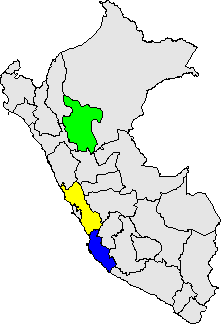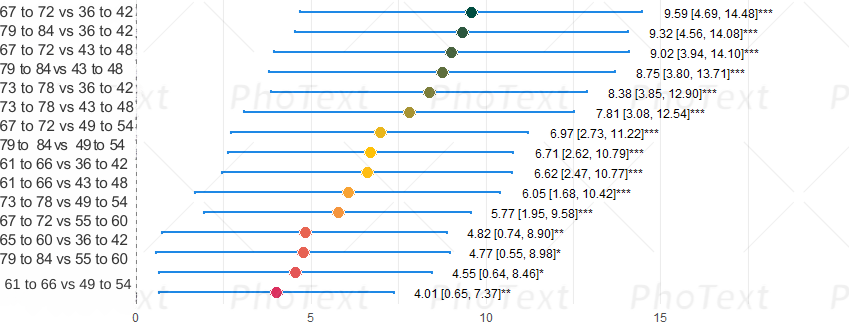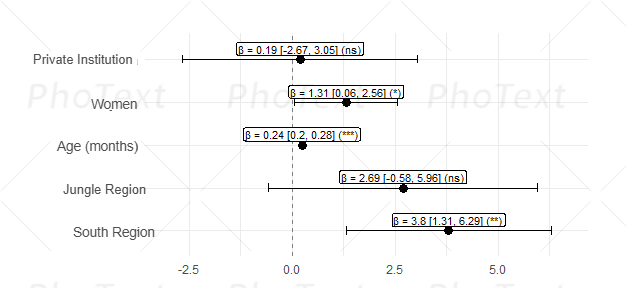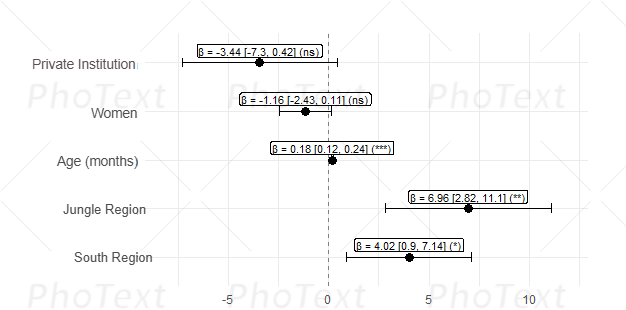Estudios originales
← vista completaPublicado el 17 de julio de 2025 | http://doi.org/10.5867/medwave.2025.06.3056
Habilidades motoras en niños de educación preescolar peruanos: estudio transversal
Motor skills in Peruvian preschool children: A cross-sectional study
Abstract
Introduction Motor skills encompass a series of movements essential for daily activities and have been associated with well-being and child development. However, there are various external and internal conditions that can affect children’s motor development. Therefore, the purpose of our study was to analyze the motor skills of Peruvian children aged three to six years and compare differences based on region, sex, age, and type of educational institution.
Methods An observational study was conducted with a sample of 265 children aged three to six years from public and private institutions in three regions of Peru: the central region (Metropolitan Lima), the jungle region (Tarapoto), and the southern region (Chincha Alta). The Test of Gross Motor Development, Third Edition (TGMD-3) was applied. Data were processed and analyzed using descriptive statistics and non-parametric tests such as the Mann-Whitney U test and Kruskal-Wallis test (p<0.05). Additionally, a multiple linear regression analysis with robust standard errors was conducted.
Results The results revealed significant differences between regions. Children from the Selva (Tarapoto) and Sur (Chincha) regions of Peru reported higher scores than those from the central region. In addition, girls reported higher scores than boys in locomotor skills. Also, it was found that motor performance usually reaches better performance after five years and six months of age.
Conclusions It is concluded that infant motor performance varies by region, age and sex. Therefore, future interventions adjusted for these variables are required to strengthen and improve these skills.
Main messages
- Children’s motor development can be affected by multiple sociodemographic and contextual factors. In countries with high geographic diversity and inequalities, such as Peru, the motor skills of preschool children require special attention.
- This is one of the first studies in Peru to analyze child motor development using an international standardized test to assess gross motor skills, and to compare results between three different geographic regions, while also considering variables such as sex, age, and type of institution.
- The sample size and type of sampling limit the generalizability of the results. Additionally, other individual factors that could influence motor development were not evaluated.
Introduction
The development of motor skills is fundamental for the development and well-being of the child [1]. These skills encompass both fine and gross motor skills. The former involves the control and coordination of small muscles in the feet and hands, such as using cutlery, writing with pens, or stringing pieces in a puzzle [2]. Likewise, gross skills involve a range of movements, such as walking, jumping, and running, as well as throwing or catching objects, and a sense of balance [3]. In this regard, motor mastery in these skills enables the efficient execution of voluntary and coordinated movements, which is a key aspect of child development.
Several proposals have been made in various countries to develop educational programs that enhance motor skills in preschool, school, and adolescent children [4]. According to a review, motor training programs have yielded effective results [5], and children who master or adequately develop these skills have shown improved performance in sports activities during adolescence and adulthood, which is a significant indicator of their physical health [6].
For assessing motor development in children, several standardized instruments are available [7]. One of the most popular assessments is the Test of Gross Motor Development (TGMD), which evaluates gross motor skills through the performance of locomotor and object control skills in children, providing a detailed and comprehensive result of the state of motor development [8]. The TGMD is a tool with solid psychometric properties, having been standardized for diverse populations and cultures. Its application does not require specialized materials or equipment. Its use is practical compared to other batteries [9].
A worldwide review of motor skills performance reported that children exhibit below-average performance levels, and their performance is affected by various factors [10]. For example, a review has evidenced that children with low birth weight or preterm, presented significant negative associations with motor performance [11]. In Brazil, a study revealed that the mother’s age, economic poverty, and working outside the home were correlated with poor motor performance in the child [12]. Similarly, a study in Africa found a positive association between food security, dietary diversity, and child motor development.
Several studies have demonstrated the benefits of motor skill development on children’s physical, cognitive, and socioemotional health [13]. For example, in Canada, children with motor stimulation reported more participation in physical activities and a lower risk of developing obesity [14]. Another national study with children in the United States reported that motor skills were negatively associated with childhood obesity [15]. A study involving children in Norway found that motor skills may have the potential to positively impact academic performance [16] positively.
Several studies have revealed significant gaps in childhood motor development [17]. For example, a study done in nine developing countries reported that, unlike boys, girls reported a significantly higher average [18]. Likewise, a study in Portugal found that girls demonstrated better locomotor skills, while boys performed better in ball skills [19]. In addition, a study with children in Hong Kong revealed that children in private preschools reported better performance in locomotor skills than children in public preschools, suggesting that these skills are affected by the physical environment of their schools [20].
Peru is composed of three regions: the Coast, the Jungle, and the South, each with its unique geographic conditions and lifestyles. For example, the Coastal Region is situated near sea level, has a sunny climate, and is characterized by urbanized areas. The Southern Region, on the other hand, is located at a high altitude, surrounded by mountains with a cold climate, and features agricultural, mining, and commercial activities. Additionally, the jungle region features a tropical and rainy climate, as well as abundant vegetation. Its primary source of economic income is tourism and commerce. Likewise, in the Peruvian territory, several conditions may be affecting the normal development of motor skills. For example, approximately 10% of the population is under five years of age, and the prevalence of anemia in this group is 32% according to the World Bank [21]. Similarly, it is estimated that 8.6% of children under five years of age and 38.4% of children between 6 and 13 years of age are overweight [22]. At the level of Peruvian public schools, a report indicates that, in general, there is an insufficient infrastructure and services, with the Selva Region experiencing the greatest problems compared to the Coastal and Southern Regions [23].
A study conducted on Peruvian children aged 6 to 10 years revealed that more than half of the children reported average motor performance, with a risk of moving to a lower level [24]. The study also highlights that motor performance is correlated with the natural environment, reporting a better average in children from the Peruvian jungle compared to those from the coast and South [24]. However, the study does not examine whether there are differences by gender, age, or type of institution. Likewise, another study with Peruvian children aged 6 to 14 years found that motor performance problems increase with age, and that, compared to boys, girls are five times more likely to report motor difficulties. Additionally, infants from the coast have less motor performance control. The study, however, does not report psychometric properties of the instrument used. Additionally, the instrument lacks activities designed to assess locomotor skills [25].
Therefore, the purpose of our study was to evaluate the motor skills of Peruvian children aged three to six years, while also estimating differences between regions, sexes, age groups, and types of educational institutions.
Methods
Design
This was a descriptive cross-sectionalstudy. The study’s structure adhered to the guidelines proposed by the Strengthening the Reporting of Observational Studies in Epidemiology (STROBE) [26].
Setting
The study consisted of children aged three to six years residing in three geographical regions of Peru: the Coast (Metropolitan Lima), the Jungle (Tarapoto), and the South (Chincha Alta). These geographic areas present differentiated socioeconomic and cultural characteristics (see Figure 1) [27].
Map of Peru with the regions that participated in the study.

First, various educational institutions in each region were contacted through formal communications addressed to the institutional e-mail addresses of their principals. In these communications, the objectives of the study were explained, and participants were requested to authorize their participation. Then, a visit was made to the schools that agreed to participate. Then, permission to enter was requested from the principals of the educational institutions selected for the study. Likewise, informed consent was obtained from the children’s parents and each child. Only with these permissions were the recruitment and evaluation activities carried out. A total of seven preschool educational institutions participated: three in Metropolitan Lima (two private and one public), two in Tarapoto (one private and one public), and two in Chincha Alta (one private and one public).
Prior to conducting the evaluations, training was given to the evaluators with the following objectives:
-
To train the evaluators in the application of the TGMD-3 tests using their respective manuals.
-
To collect informed consent from the parents and the assent of the children interested in participating in the study.
Consent was obtained through a parent school and by telephone to each parent. Parents were informed about all aspects of the project related to their child’s participation.
Six evaluators (four undergraduate psychology students and two psychologists with experience in child assessment) conducted the motor skills assessment for two months in 2023. The assessments were conducted in an environment free of movement in the institution’s sports schoolyard. This place was chosen because it offered a large and uninterrupted space for the children to move around. Each child was asked to perform various activities at least twice, following the TGMD-3 protocol. A video camera (Canon R50 model, 18-45 millimeter lens) was used, placed at a distance of five meters in the sagittal direction and at a height of 1.50 meters, for video capture of the activities. The testing schedule varied from regular school hours. The children wore shoes and clothing that allowed for the evaluation of motor skills (sneakers, overalls, shorts, and T-shirts). The videos were classified with codes that corresponded to the codes of the motor skills tests and questionnaires. All this material was hosted in the cloud with access restricted only to the study investigators.
Participants and sample size
Participants were selected by nonprobability purposive sampling. Children of both sexes, from 3 to 6 years and 11 months of age, without any physical limitation reported as sequelae of temporary accidents, were included. Only children with typical development, as reported by teachers and caregivers, were considered. This means without neurological and/or developmental conditions that could affect test performance. Likewise, data from children who did not adequately complete the assessments or whose videotaping did not allow the assessment to be performed correctly were excluded. The sample size was determined by the availability of children at the participating institutions, with their parents' consent, and in accordance with the established inclusion criteria. Finally, a sample of 265 participants was analyzed.
Sources of measures
First, the questionnaire was used to collect sociodemographic characteristics of all participants through their parents. The required information was: sex (male or female), region (Coast, Jungle, or South), age (in months), and type of institution (public or private).
Then, the Test of Gross Motor Development (TGMD) was used. This test was initially developed by Ulrich et al. in 1985, and its third edition was published in 2018. This test was applied to the US school population. The TGMD-3 assesses the performance quality of six locomotion skills (running, jumping in place, gliding, galloping, hopping forward with one foot and with both feet), and six manipulation skills (kicking a ball, bouncing it in place, throwing a ball over and under the shoulder, catching a ball with the hands, and hitting a ball with a bat). Each skill is scored based on specific performance criteria proposed in the TGMD. These are scored dichotomously:
-
1 (present): if the child correctly executes the criterion.
-
0 (absent): if the child does not perform it adequately.
The total score in each subtest (locomotion and manipulation) is obtained by adding the direct scores of the corresponding skills. Thus, a raw score is converted into percentiles and standard scores according to the TGMD [8].
The original TGMD-3 has shown strong evidence of reliability. For example, intraclass correlation coefficients greater than 0.88 have been reported for assessing inter-rater consistency in preschool children, as well as Pearson correlations greater than 0.91 when compared to similar tests. All this supports its convergent validity [28]. In Peru, Mamani-Ramos et al [24] validated the TGMD-3 in a sample of children aged 6 to 10 years. In this context, adequate reliability indicators were reported: internal consistency (α = 0.851), temporal or test-retest stability (r = 0.951), inter-rater reliability (intra-rater correlation coefficient: 0.963), and intra-rater reliability (intra-rater correlation coefficient: 0.983), considered acceptable for determining the reliability of the TGMD-3 in Peru.
Statistics
A descriptive analysis was performed using frequencies and percentages for our categorical variables, while the numerical variables were presented as mean and standard deviation.
The comparative analysis of the data, after applying Kolmogorov normality tests (sig > 0.05) and not meeting the assumptions (homogeneity), we decided to use nonparametric tests such as Mann-Whitney U for two groups, and Kruskal-Wallis for more than two groups, considering significance when the value is p < 0.05. Additionally, multiple comparisons were performed using Dunn’s test with the Bonferroni correction to identify specific differences between groups. Likewise, a multiple linear regression analysis with robust standard errors (HC1) was performed to evaluate differences while adjusting for the remaining variables.
Ethics
Our study was reviewed by the Research Ethics Committee of the Universidad Autónoma de Ica (CIE-UAI) on September 1, 2023. Likewise, the fundamental ethical principles proposed in the Helsinki Declaration for research work involving human beings were followed, such as beneficence, justice, and respect [29]. This was ensured through the informed consent obtained from the children’s parents, the requirement of verbal assent for each minor, and the request for approval from each director of the educational institutions visited.
Results
A total of 265 children were evaluated; 50.9% (n = 135) of the participants were female, with the most prevalent ages between 61 and 66 months, equivalent to 20.8% (n = 55). Of the children, 50.6% attended private educational institutions (n = 134) and 41.9% were from the Central Region (n = 111) (Table 1).
Locomotor skills were slightly higher in girls (difference 0.7; 95% confidence interval: -0.64 to 2.05) compared to boys, and object control skills were lower in girls (difference -1.45; 95% confidence interval: 2.79 to -0.11). However, in both cases, no statistically significant differences were found (Table 2).
Children from private educational institutions reported higher and significant (p < 0.001) locomotor skills (difference 4.1; 95% confidence interval: 2.82 to 5.45) and object control skills (difference 3.49; 95% confidence interval: 2.16 to 4.81) compared to children from public institutions (Table 2).
It was identified that the highest locomotor skills were in the 6.6 to 6.11 years group (difference 11.79; 95% confidence interval: 7.11 to 16.46) when contrasted with the 3.0 to 3.5 years group. In general, the older age groups (79 to 84, 73 to 78, and 67 to 72 months) show the largest differences (all greater than 7 points) compared to the younger age ranges (36 to 42 and 43 to 48 months) (Figure 2). Likewise, it was observed that object control skills were greater (difference 9.59; 95% confidence interval: 4.69 to 14.48) in the 5.6 to 5.11 years group compared to the 3.0 to 3.5 years group. In that sense, children with month ranges of 67 to 72, 73 to 78, and 79 to 84 reported higher differences (greater than 8 points) compared to children in lower month ranges (36 to 42, 43 to 48 months) (Figure 3). Following this line, at older ages, the scores in both types of skills are also higher (see online supplementary tables 0103) [30].
Significant comparisons of locomotion skills and age range in months.
Difference in locomotor skills (points).

*** p < 0.001.
** p < 0.01.
* p < 0.05.
Source: Prepared by the authors of this study.
Significant comparisons of object control skills and age range in months.
Difference in object control skills (points).

*** p < 0.001.
** p < 0.01.
* p < 0.05.
Source: Prepared by the authors of this study.
Children from the Selva and Southern Region obtained higher differences in locomotor skills (difference 5.23; 95% confidence interval: 3.48 to 6.99 and difference 4.76; 95% confidence interval: 2.67 to 6.85) and object control (difference 5.40; 95% confidence interval: 3.65 to 7.15 and difference 2.66; 95% confidence interval: 0.57 to 4.75) compared to the children in the Peru center (Table 2 and online supplementary tables 0204), in all cases there were significant differences (p < 0.001).
After multiple linear regression analysis, adjusted for age, sex, and type of institution, it was found that, concerning the Central Region, only the Southern Region presented significantly higher scores in locomotor skills (β = 3.80; 95% confidence interval: 1.31 to 6.29; p < 0.01). In terms of object control skills, both the Selva Region (β = 6.96; 95% confidence interval: 2.82 to 11.1; p < 0.001) and the Southern Region (β = 4.02; 95% confidence interval: 0.9 to 7.14; p < 0.05) showed significant differences compared to the Central Region. Likewise, for each additional month of age, a significant increase of β = 0.24 (95% confidence interval: 0.2 to 0.28; p < 0.001) was found in locomotor skills and β = 0.18 (95% confidence interval: 0.12 to 0.24; p < 0.001) in object control skills. In locomotor skills, girls reported significantly higher scores than boys, with a β of 1.31 (95% confidence interval: 0.06 to 2.56; p < 0.05). Finally, the type of public and private institutions did not reveal significant differences in any of the skills (see Figures 4 and 5).
Results of multiple linear regression analysis on locomotor skills in Peruvian preschool children.

Model adjusted for age, sex, and type of institution (adjusted R2 = 0.14).
*** p < 0.001.
** p < 0.01.
* p < 0.05.
ns = not significant.
Source: Prepared by the authors of this study.
Results of multiple linear regression analysis on object control skills in Peruvian preschool children.

Model adjusted for age, sex and type of institution (adjusted R2 = 0.42).
*** p < 0,001.
** p < 0,01.
* p < 0,05.
ns: not significant.
Source: Prepared by the authors of this study.
Discussion
The results showed better locomotor performance in girls compared to boys, and vice versa, in object control skills. These findings are consistent with previous studies, which have reported differences in motor skill progress between boys and girls during early developmental stages [31,32]. For example, a study with Australian boys reported that they were more proficient in object control than girls [33], while in Costa Rica, boys outperformed girls in both skills [34]. A review shows that competence in locomotor skills tends to develop more favorably in girls, while object control skills tend to develop more favorably in boys [35]. These variations may be due to the cultural and social influences of the environment, which could promote in girls the participation in activities such as dance or gymnastics, which facilitate body movement skills. Meanwhile, boys are encouraged to participate in activities that require greater strength and forcefulness [36,37].
Along these lines, in our comparative findings, preschoolers from private institutions performed better in both skills. However, after adjusting for the regression analysis, this result did not maintain its statistical significance despite these different studies, such as the one reported by Santos et al [38], which found that the motor performance scores of children attending public day care centers are lower compared to those attending private day care centers. Similarly, Tomaz et al. [39] found significant differences in motor performance among South African children from different school conditions. Similarly, a study with children in Brazil revealed how infants in public schools had a 5.5 times higher risk of having motor problems compared to children in private schools [40]. These results could be because private schools have more resources (specialized teachers), adequate environments (spaces, toys, materials), and activities that help improve motor skills. All this could lead to better results [41,42]. Additionally, the economic income of children in private institutions may be higher, facilitating participation in sports and socialization activities, as well as better nutrition, which supports their development [43].
Our findings indicate that children typically develop better motor skills with age. This is in agreement with some previous studies. For example, in the study by Valentini et al. [44] involving Brazilian children, it is concluded that motor skills improve significantly and begin to stabilize with age. In Belgium, a study observed better performance in motor skills with increasing age [45]. Likewise, a study with infants in Ireland revealed that older children scored significantly higher than younger children in both skills [46]. These findings may be attributed to the fact that as children grow older, they develop greater muscle power, balance, and coordination [47,48]. On the other hand, Gallahue and coworkers mention that children learn to move better in simple activities (such as running and jumping) as they grow older. This increase in abilities is notable during the early childhood stage, when infants show rapid progress in mastering their bodily functions [1].
The results of improved motor performance of children from the Jungle Region and Southern Peru have been reported in other studies. For example, Santos et al [49] in their study found that children aged 6-14 years living in the Peruvian Amazon had better gross motor coordination than children living at sea level. Similarly, Mamani-Ramos et al [24], reported that children aged 6 to 10 years from the Peruvian jungle presented superior motor competence than those from the coast. This finding may be attributed to specific conditions in the Peruvian regions. Thus, for example, in regions such as the jungle and the South, children are typically exposed to natural environments that encourage physical activities, including running, climbing, walking long distances, and playing outdoors [50]. In addition, children are often subjected to activities that support their parents in various tasks or workdays, such as harvesting, transporting, and carrying materials. All these actions involve body movement and displacement [51]. On the other hand, in urbanized areas such as central Peru, there are limited spaces for free play and playgrounds, with difficulties in accessing them [52].
Our study has strengths and limitations that must be stated. First, as a strength, our study offers the first evaluation in Peru that performs a motor analysis in children aged 3 to 6 years. The analyses performed made it possible to compare children’s motor performance according to some sociodemographic variables. It also facilitates the estimation of adjusted associations between these characteristics, providing greater precision on the current state of motor skills in Peruvian preschoolers. Third, samples from three regions of Peru (Central, Jungle, and South) were included, providing a diverse comparative view of children’s motor performance in different geographic areas of the country. However, our study employed purposive sampling, which limits the generalizability of our results.
Additionally, our study did not collect certain anthropometric characteristics (such as height and weight) that may also impact child motor performance. For this reason, future studies should investigate the relationship between these variables. In this context, it is likely that the regions considered in the study present differences in determinants of health, such as socioeconomic status, access to health services, and opportunities for motor development. Therefore, these variations could have affected children’s performance in the assessments. Therefore, further work should explore and consider these differences, using a design that is more representative of the Peruvian child population.
On the other hand, although the evaluators were trained in the application of the TGMD-3 to ensure accurate data collection, future studies could consider including specialists in psychomotor skills or kinesiology during data collection. This, to enrich and complement the evaluation and interpretation of the results. Likewise, it is important to note that the size of the groups varied significantly among the country’s regions. For this reason, the results should be interpreted with caution, and future research will need to consider a more balanced distribution of the sample to enhance comparability between regions. Additionally, the recruitment process of educational institutions likely introduces a selection bias. Therefore, strategies that facilitate greater randomization in the inclusion of institutions should be considered to improve the representativeness of the sample. Finally, although we used an instrument validated in Peru, it requires further psychometric analysis of its performance for the particular population aged 3 to 6 years. Nevertheless, in our study, we utilized ratings from six raters to minimize error bias and obtain more accurate results.
Conclusions
Based on the above, we conclude that infant motor performance in Peru exhibits significant differences among various characteristics of preschoolers.
On the other hand, girls reported significantly better locomotor performance. In addition, motor performance improves with age. In terms of geographic location, children from the cities of La Selva (Tarapoto) and Sur (Chincha) in Peru demonstrated better motor performance.
Ultimately, new studies are needed to develop further and expand the understanding of these findings, incorporating additional variables, characteristics, and methodological nuances.

